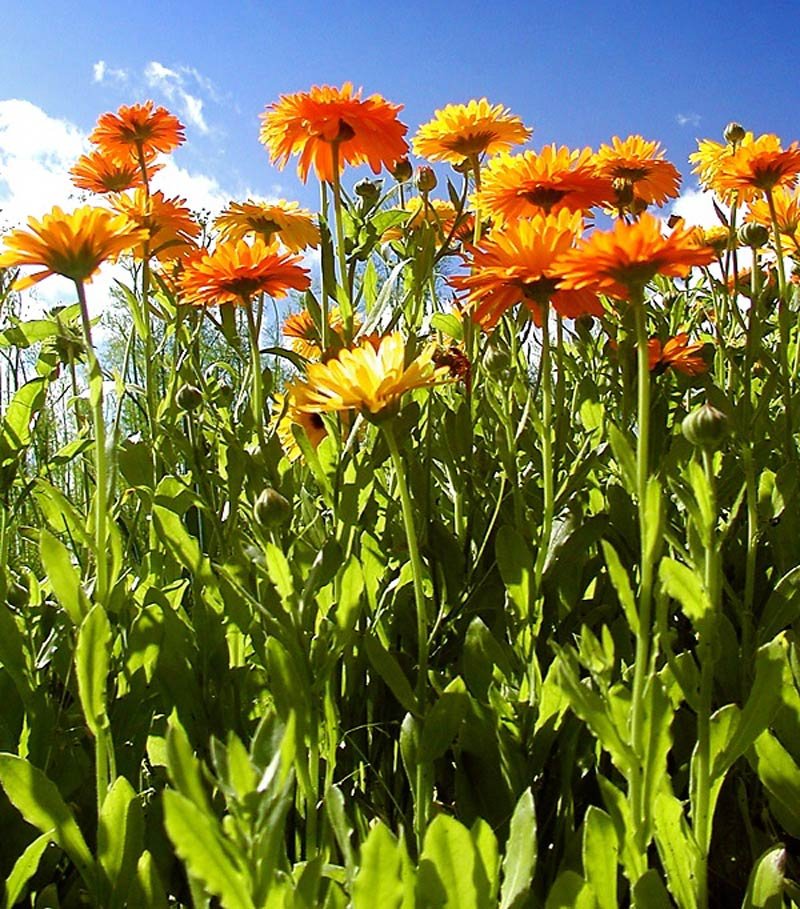
Botanical Name: Calendula Officinalis
Family Name: Asterceae
Kingdom: Plantae
Division: Magnoliophyta
Class: Magnoliopsida
Order: Asrerales
Family: Asteraceae
Tribe: Calenduleae
Genus: Calendula
Species: R. cordifolia
Popular Names: Pot Marigold, Garden Marigold, Holigold, Mary Bud, Pot Marigold, Calendula, Caltha, Ganda, Gols Bloom, Gold Bloom, Ruddes.
Parts Used: Dried marigold flowers, dried marigold petals, leaves and roots
Habitat: Cultivated in gardens in India
Description
An annual herbaceous plant, calendula blooms at the start of almost every calendar month. The basal leaves are spathulate and stalked, while the pale green stem leaves are lanceolate, alternate and sessile. The plant bears flowers in bright yellow, red and orange colours. The fruits are rough and curved achene. The plant is cultivated in the kitchen gardens around India, for the flowers that are dried for broth. Marigold is native to Egypt and the Mediterranean, but has become naturalized in the temperate regions of the world. It can be found throughout India and is widely grown in the Valley of Flowers in Ranthambore National Park. The plant is known as zergul in Hindi.
Plant Chemicals
(+)- flavonol glycosides, triterpene oligoglycosides, oleanane-type triterpene glycosides, saponins, sesquiterpene glucoside, bitter glycosides, sterols, flavonoids, mucilage
Uses and Benefits of Marigold
- Marigold is useful in stomach upsets, ulcers, menstrual problems, eye infections, inflammations and wound healing.
- The plant is antiseptic. Its flower, when rubbed on the affected part, relieves pain and swelling caused by a wasp or bee.
- The flowers are also used to make a lotion for sprains and wounds.
- The water distilled from marigold flowers is good for sore eyes, while the infusion of fresh flowers is beneficial in fever.
- Marigold is used to treat alopecia, bladder and kidney problems, blood in the urine and uterine bleeding.
- Bright yellow and orange flowers are used for making garlands and decorating religious places.
- The leaves are used as a part of salads.
- The plant is used for abdominal cramps and constipation.
- Marigold is good for treating bedsores, chapped lips, leg ulcers, persistent ulcers, bruises and varicose veins.
- It is used during aromatherapy, as a skin treatment.
- Marigold cream treats haemorrhoids and an infant’s bums to help fight diaper rash.
- The flower is boiled to extract a yellow dye.
- It serves as an excellent mouthwash after tooth extraction.
Cautions
- Pregnant and breast-feeding women should avoid using marigold.
- Combining other herbs with marigold can alter its action or produce unwanted side-effects. Consult your health practitioner before using any prescription.
- Marigold carries a risk of allergic reactions. Consult your doctor in case you experience any.

